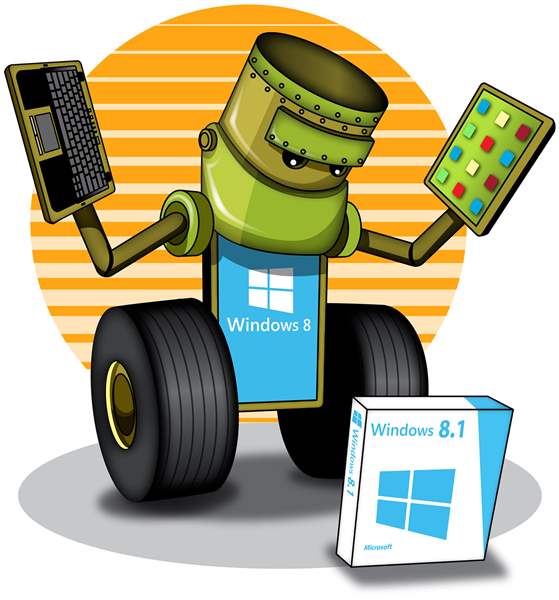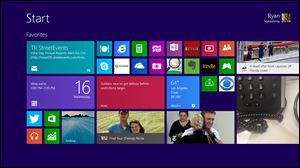
Baby steps, but Microsoft fails to end Windows 8 woes
10/19/2013
BLADE ILLUSTRATION BY TOM FISHER

Just about one year ago, Microsoft gave us two new operating systems.

A prerelease version of Windows 8.1 is shown on a tablet. Microsoft launched its Windows 8.1 upgrade as a free download this week. It addresses some of the complaints people had with Windows 8.
One was a new version of Windows: the one for use with mouse and keyboard, the one whose desktop at this moment lights up hundreds of millions of screens, the one with a software library of 4 million programs.
The other was a new operating system for tablets. It was modeled on Microsoft’s lovely tiled Home screen for Windows Phones: colorful, clear, elegant, filled with fluid touch gestures. You can’t run Photoshop or iTunes or Quicken on it; this new system requires a whole new type of app. Microsoft doesn’t have a name for this OS (it abandoned the names Metro and Modern), so I call it TileWorld.
All of this might have been fine, except for one tragic miscalculation: Microsoft mashed these two new operating systems together into something called Windows 8.
Now you have two Web browsers to learn. Two completely different Help systems. Two (actually three) control panels. Two kinds of programs: the traditional ones, which have menus and overlapping windows, and TileWorld apps, which don’t have either of those things.
Reviewers and PC fans gave Microsoft quite a swat on the nose. PC World wrote that Windows 8 is “not worthwhile” for desktop computer users. PC Magazine: “Too drastic for some.” InformationWeek: “A big flop. Its Frankenstein interface combines two fundamentally incompatible operating systems.”
PC sales plunged 14 percent in the months after Windows 8’s release. The executive who masterminded Windows 8 abruptly left the company.
Microsoft, licking its wounds, spent a year trying to fix Windows 8. Now you can download the result: Windows 8.1. It’s free to anyone who already has Windows 8, and it will come preinstalled on new computers. (Full disclosure: I have written a how-to book on Windows 8 and will be updating it for Windows 8.1.)
The changes to TileWorld are nearly endless — and terrific. The anemic, pared-down starter apps, such as Photos and Mail, have matured. Now you can edit photos in Photos (not just look at them) and drag email messages into folders. The muddled Music app has been redesigned, smartly and handsomely.
A suite of utility programs is there now, right where they should have been the first time around: Alarms, Calculator, and Sound Recorder. There are also all-new apps, such as Food and Drink, Health and Fitness, and Reading List. It lets you save Web pages, email messages, and Twitter posts for use when you have no Internet connection.
You have more options to tailor your desktop, Start screen, and Lock screen in Windows 8.1. For example, you can make your Lock screen a slideshow, so that your tablet is a photo frame whenever you’re not working.
The Help system in Windows 8 was practically nonexistent; in many apps, it was completely nonexistent.
“If Windows 8 isn’t easy enough to understand without reading Help screens, then we’ve failed,” a product manager told me at the time.
Well, hate to tell you this, but ...
In any case, there’s now a full-blown Help and Tips app for TileWorld, which is clear, concise, and crisp. The first time you use Windows 8.1, moreover, huge billboards with arrows pointing to the corners of the screen help you understand the four secret places to click. Each opens a different useful panel, like recently used apps or common settings.
In Windows 8, you could split the screen between two apps, but you couldn’t control the proportions of the screen occupied by each. Now you can. If you have a high-resolution screen, in fact, you can open more than two apps simultaneously. It’s a reasonable replacement for the loss of multiple windows.
The on-screen keyboard is better, now, too. You can swipe your finger across the space bar to view alternative autocomplete suggestions.
Finally, Windows 8.1 is even more tied in to your SkyDrive, a free, 7-gigabyte online “hard drive.” When you create a new document, you can save it either to your Windows machine or your SkyDrive.
These are all wonderful and welcome changes. What you may have noticed, however, is that virtually all of them are changes in TileWorld. All of them are designed for touch screens. These changes are solely for the benefit of the handful of people who’ve bought Windows 8 tablets and touch-screen laptops.
On the other hand, almost nothing has changed for people who use the real Windows, the desktop Windows.
And none of the changes listed above addresses the elephant in the room: the jarring juxtaposition of TileWorld and the traditional Windows behind it.
Fortunately, Microsoft has taken a few steps toward reconciling these two wildly different worlds.
The big news is that the Start button is back at the desktop, in the lower-left corner. Yet incredibly, despite the wails of the masses, clicking it still doesn’t open the Start menu. Instead, it just takes you back to TileWorld.
Microsoft’s logic: You’re supposed to think of TileWorld’s Start screen as an expanded, tile-based version of the Start menu. It’s the same items, just spread across your screen. So clicking the Start button does, in a way, take you to your Start menu items. (If you prefer the real Start menu, you can still install Classic Menu or another free app that brings it back.)
Furthermore, you no longer need some piece of shareware to make your PC start up to the desktop instead of TileWorld; there’s a buried setting to do that, too.
You can now choose the same desktop picture for both TileWorld and the desktop.
There are some other changes.
We should be grateful for these baby steps. Unfortunately, all of it is a giant exercise in rearranging crackers on plates on deck chairs on the Titanic.
The fundamental problem with Windows 8 hasn’t changed: You’re still working in two operating systems at once. You’re still leaping from one universe into another — the color schemes, fonts, and layouts all change abruptly — and it still feels jarring. There are still too many duplicate programs and settings, one in each environment. And you still can never live entirely in one world or the other.
The more you work with Windows 8, the more screamingly obvious the solution becomes: Split it up. Offer regular Windows on regular computers, offer TileWorld on tablets. That way, everyone has to learn only one operating system, and each operating system is suited to its task.
There’s a reason Microsoft mostly ignored the traditional Windows desktop world in Windows 8.1; the company is betting that all computers will someday have touch screens. Maybe Microsoft actually believes that someday, the mouse, keyboard, menus, and windows will go away. In that case, the lovely, fluid, vastly improved TileWorld will be all anybody needs.
Unfortunately for that vision, reality seems to have other ideas.